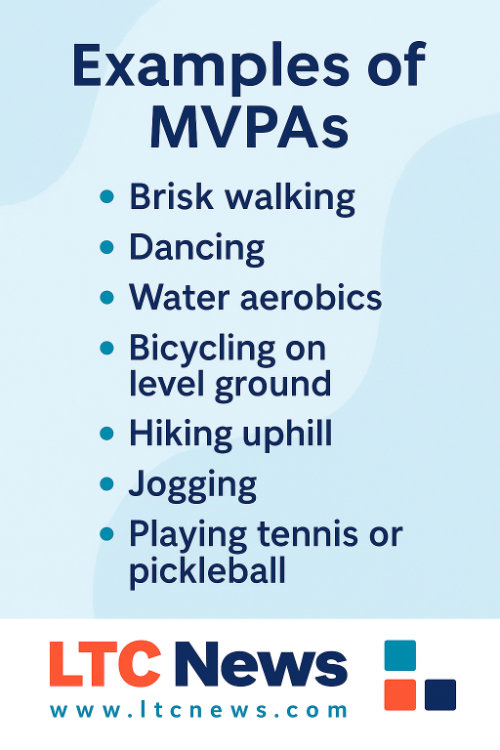Stay Active, Age Well, Improve Well-Being: The Science Behind Physical and Mental Engagement

You don’t need to run marathons or memorize Shakespeare to age well, but what you do every day matters. Maybe it’s the walk you take after lunch, the crossword puzzle by your coffee, or the phone call you make to an old friend. These small choices, repeated over time, shape not just how long you live—but how well you live. And that’s the real goal: not just more years, but better ones.
University of Chicago Medicine researchers found that when older adults simply increased their walking pace by 14 steps per minute, markers of frailty—fatigue, weakness, trouble with daily tasks—showed measurable improvement.
Research shows active lifestyles—keeping up strength, endurance, balance, and agility (mental and physical)—can lessen challenges associated with increased age. This movement (pun intended) to improve quality of life for older adults can also help change our collective negative perception of aging." — Janejira Chaiyasit DNP, AGNP-C, adult-gerontology primary care provider at the Nurse Practitioner Group of ColumbiaDoctors Primary Care.
A Cambridge study involving nearly 1,500 participants aged 60 and above found that even small increases in sedentary time were associated with poorer quality of life, whereas maintaining physical activity had the opposite effect.
Keeping yourself active and limiting… the amount of time you spend sitting down is really important… particularly in later life.” — Dr Dharani Yerrakalva from the Department of Public Health and Primary Care at the University of Cambridge.
Additionally, a major meta‑analysis showed that 150 minutes per week of moderate activity reduced all‑cause mortality by up to 40%, and 30–40% for cardiovascular disease. The message? It’s never too late—and every step counts.
Brain Health: Boosting Cognitive Reserve Through Movement and Engagement
Aerobic exercise, such as brisk walking, jogging, and cycling, has well-documented neurological benefits—enhancing neuroplasticity, boosting BDNF levels, and increasing gray matter volume in memory-related brain regions. Notably, individuals with regular aerobic activity preserve hippocampal volume better, counteracting age-related decline.
Moreover, studies from Johns Hopkins and Barcelona have revealed that moderate-to-vigorous physical activity (MVPA) reduces the risk of dementia by as much as 41 percent, with even one minute of MVPA per week showing a beneficial effect.

Mental & Social Engagement: A Vital Part of the Equation
With 79 percent of adults age 60 and older living with two or more chronic conditions—such as diabetes, heart disease, or high blood pressure—and more than half of younger adults reporting at least one chronic illness, health experts are shifting their focus. It’s no longer just about how long people live, but how many of those years are spent in good health.
That’s known as a person’s healthspan—and like the U.S. lifespan, it’s been declining.
Healthspan means living better, not just longer. We're talking about those years that are free from any significant chronic disease or any significant disability that might affect one's quality of life."—Dr. Corey Rovzar, a postdoctoral fellow at the Stanford Prevention Research Center within the university's School of Medicine in California.
Additionally, mental stimulation—through puzzles, learning new skills, or VR exergames—reinforces cognitive inhibition and promotes motivation. A recent longitudinal trial using a VR “LightSword” exergame over eight months significantly improved cognitive control in those 60 and older.
Social activity is equally powerful.
The health risk of social isolation is comparable to the risks of smoking, high blood pressure, and obesity… enjoyable recreational activities… foster multiple psychological and physical benefits.” —Roger Walsh, a well-being expert.
Loneliness in older adults is strongly linked to depression, anxiety, and poorer physical health. Keeping connected—through clubs, volunteering, or tech—fosters resilience and sharpens mental health.
Finding Social Activities for Older Adults
For many older adults, finding ways to stay active in their local communities can be a challenge, especially after retirement, the loss of a spouse, or a move to a new neighborhood.
Most communities offer activities tailored for older adults through senior centers, park districts, libraries, and faith-based organizations. These programs may include everything from low-impact fitness classes and gardening clubs to memoir-writing workshops and technology help sessions. Many offer free or low-cost transportation.
For example, if you have a loved one living in Burleson, Texas, finding social activities might seem challenging, but a quick internet search can reveal many options for older adults to enjoy.
Like many communities, local cities and towns offer various services. In the City of Burleson, the Senior Activity Center offers a diverse range of programs, activities, and services for Burleson's senior citizens.
In Burleson, and most cities, there are attractions for seniors that can provide stimulating and entertaining experiences. Engage in local festivals and cultural events, which are great for both excitement and socializing.
Simply search for your city or town and "social activities for older adults," and find available activities. Encourage your loved ones to take part in them.
Strength & Balance: Safeguarding Independence and Preventing Falls
Resistance and balance exercises—like Pilates, chair yoga, or Otago method training—strengthen muscles and improve posture. These moves not only slow sarcopenia (muscle loss) but also substantially lower the risk of falls, a leading cause of injury among older adults.
Practical Takeaways
- Walk with purpose. Try to slightly speed up your pace—14 extra steps per minute can boost strength and reduce frailty.
- Mix it up. Aim for 150 minutes per week of moderate activity, combining aerobic and resistance training for balance and fall prevention.
- Stimulate your mind. Engage in games, puzzles, hobby classes, or even VR tools to sharpen thinking and mental resilience.
- Build social bonds. Prioritize interactions—book clubs, volunteer groups, park walks—to combat isolation and enrich life.
- Start today. It's never too late: even small, consistent steps can meaningfully improve health and quality of life.
By embracing physical movement, mental challenges, and social connection, older adults can enjoy more than just longer years—they gain better, healthier, and more fulfilling lives.
Finding the Right Elder Care to Keep Your Loved One Active and Engaged
When an aging parent or spouse starts needing help, choosing the right kind of care isn’t just about safety—it’s about preserving their independence, dignity, and daily joy. One of the most important things you can do is find care that keeps them engaged socially, mentally, and physically, not just looked after.
Start by considering their personality and preferences. Does your loved one enjoy group settings or prefer quiet one-on-one interaction? Are they energized by art, gardening, conversation, or music? The best elder care providers don’t just assist with daily tasks—they actively promote involvement in life.
To help your loved one find high-quality caregivers and facilities, the LTC News Caregiver Directory offers a free, searchable tool that allows you to look up licensed in-home care agencies, assisted living communities, and memory care providers by ZIP code. You can compare services, read reviews, and explore which providers offer specialized activities, transportation, or wellness programs.
If you are a provider, you can claim your free listing on the LTC News Caregiver Directory and/or upgrade the listing to enhance visibility and highlight your staff and services through the LTC News Directory Business Portal.
If your loved one owns a Long-Term Care Insurance policy, don’t wait to use the benefits. Policies are designed to help pay for care early—when someone may only need "stand-by assistance" before there’s a crisis—and activating the benefits can give you access to higher-quality services and more options.
LTC News partners with Amada Senior Care and provides free, no-obligation assistance in processing a claim for any Long-Term Care Insurance policy - File a Long-Term Care Insurance Claim.
Most LTC policies cover home care, adult day care, assisted living, and nursing home services, often with built-in care coordination support. You can find a quality in-home caregiver or facility that will help keep your loved one active.
Getting help early doesn’t just protect physical health—it also safeguards mental well-being and improves quality of life. The right care setting or caregiver can provide companionship, purpose, and a structured routine that supports aging with grace and confidence.


